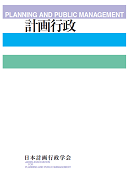Volume 29, Issue 2
Displaying 1-14 of 14 articles from this issue
- |<
- <
- 1
- >
- >|
Social Responsibility and Contribution of University
Introductory Remark
-
2006 Volume 29 Issue 2 Pages 1-2
Published: June 15, 2006
Released on J-STAGE: April 05, 2024
Download PDF (1936K)
Special Articles
-
2006 Volume 29 Issue 2 Pages 3-8
Published: June 15, 2006
Released on J-STAGE: April 05, 2024
Download PDF (7268K) -
2006 Volume 29 Issue 2 Pages 9-16
Published: June 15, 2006
Released on J-STAGE: April 05, 2024
Download PDF (10065K) -
2006 Volume 29 Issue 2 Pages 17-22
Published: June 15, 2006
Released on J-STAGE: April 05, 2024
Download PDF (7273K) -
2006 Volume 29 Issue 2 Pages 23-29
Published: June 15, 2006
Released on J-STAGE: April 05, 2024
Download PDF (9491K)
Research Paper
-
2006 Volume 29 Issue 2 Pages 30-38
Published: June 15, 2006
Released on J-STAGE: April 05, 2024
Download PDF (12536K) -
2006 Volume 29 Issue 2 Pages 39-46
Published: June 15, 2006
Released on J-STAGE: April 05, 2024
Download PDF (11297K) -
2006 Volume 29 Issue 2 Pages 47-56
Published: June 15, 2006
Released on J-STAGE: April 05, 2024
Download PDF (12214K)
Material
-
2006 Volume 29 Issue 2 Pages 57-62
Published: June 15, 2006
Released on J-STAGE: April 05, 2024
Download PDF (7841K)
Local and Regional Planning
-
Promotion Plan of Forest Management and Forming “Forest Cluster” for Realizing a Sustainable Society2006 Volume 29 Issue 2 Pages 63-70
Published: June 15, 2006
Released on J-STAGE: April 05, 2024
Download PDF (11169K)
Book Review
-
2006 Volume 29 Issue 2 Pages 71
Published: June 15, 2006
Released on J-STAGE: April 05, 2024
Download PDF (1231K) -
2006 Volume 29 Issue 2 Pages 72
Published: June 15, 2006
Released on J-STAGE: April 05, 2024
Download PDF (1262K)
Member's Opinion
-
2006 Volume 29 Issue 2 Pages 73
Published: June 15, 2006
Released on J-STAGE: April 05, 2024
Download PDF (1273K)
Donated Books
-
2006 Volume 29 Issue 2 Pages 74-76
Published: June 15, 2006
Released on J-STAGE: April 05, 2024
Download PDF (3175K)
- |<
- <
- 1
- >
- >|
